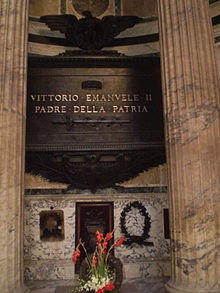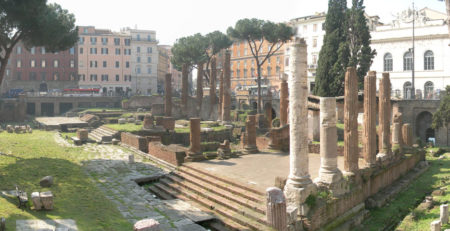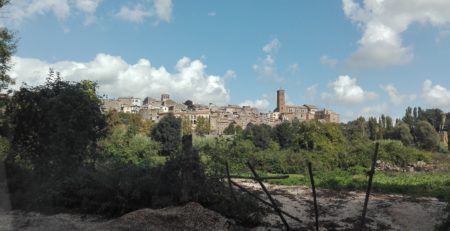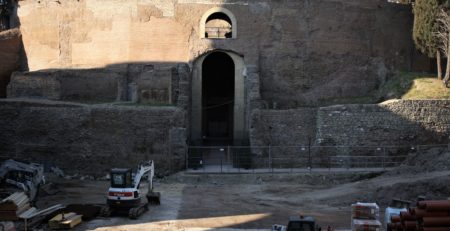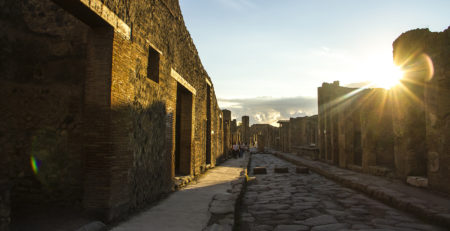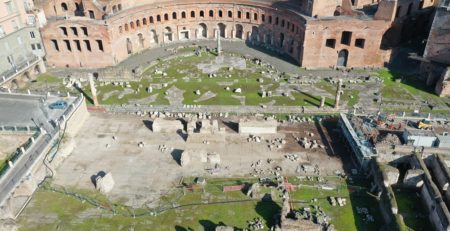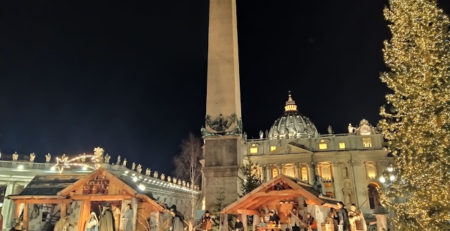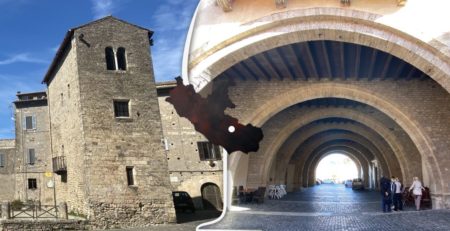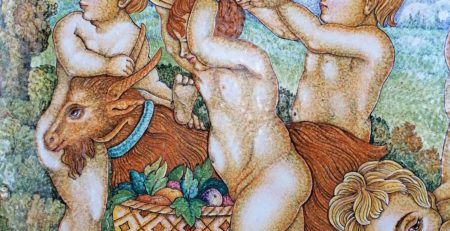The Pantheon
The Pantheon
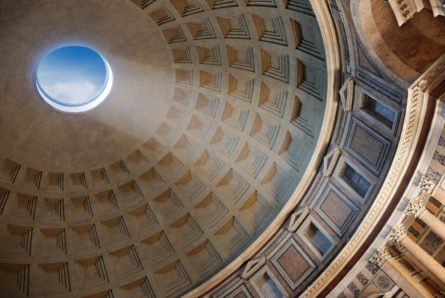
The Pantheon boasted the worlds largest dome when it was built. Today, it is the oldest most intact ancient Roman building in the world.
The original Pantheon was built by Agrippa, Augustus’ most successful general, in 27 BC. It was a rectangular building dedicated to all the Gods of the Greco-Roman Pantheon. The term ‘pan’ means all and ‘theon’ means the gods in Greek. Originally it had statues of the Roman Gods alongside Julius Caesar and Augustus inside. Caesar had been deified prior to his death and Augustus, his son, followed suit.
This original pantheon burned down in the fire of 80 AD and was rebuilt, eventually, by the Emperor Hadrian from 117 to 127 AD. It is this second building, with its distinctive dome, that you can see today. The architect of the Pantheon was, in all probability, Apollodorus of Damascus. He was the best architect of his day and handled all of Trajan’s and Hadrian’s major building work until Hadrian had him killed. Hadrian personally designed the Temple of Venus and Rome which faces the Colosseum. When the Emperor asked Apollodorus what he thought of the Temple, Apollodorus criticized it and Hadrian had him exiled and murdered.
When it was rebuilt in the twenties, the Pantheon was dedicated to all the Gods of the Empire, not just the Greco-Roman collection. This was an attempt to keep everyone happy. The outside has 16 Corinthian columns, which are all made from granite. Corinthian means the top of the columns have acanthus flowers coming out of them as opposed to scrolls or blank capitals.
The dedication underneath the architrave still bears the name of the original founder. It says: M-Agrippa-L-F-Cos-Teritum-Fecit or in English: (M)arcus Agrippa, (L)ucius (F)ilius, son of Lucius, Consulus Teritum consul (or prime-minister) for the third time, (F)ecit, made this. Hadrian put this inscription on the building instead of his own name, despite the fact this was a totally different building. It showed him to be humble and not have a big ego; such humility was popular with the masses. Beneath the large writing you might be able to see some smaller letters, the majority of which has fallen off. These smaller inscriptions tell us that repair work was also carried out by later Emperors such as Septimius Severus and his son Caracalla around 210 AD.
The ground level of Rome was lower when the Pantheon was built. There used to be five steps leading up to the building which have disappeared with the rising ground level. In the left alcove of the portico or porch, there used to be a statue of Augustus, Rome’s first Emperor, and in the alcove and on the right a statue of Agrippa, who built the first version of this building.
THE PANTHEON INSIDE
Inside is the modern Catholic update of the Pantheon, but the design is the same as that of Roman times. The Pantheon was designed to represent heaven. We have seven alcoves for the seven Gods of the Roman Pantheon. These corresponded to the seven known planets of the time. We have since discovered a further two (although Pluto has been downgraded recently), but the Romans didn’t have telescopes back then.
THE DOME OF THE PANTHEON
Inside the most striking feature is the magnificent dome. The dome is made from Roman concrete. It was built thick at the bottom, but getting progressively lighter as the dome rises. A mould was made from wood and the concrete was poured in to set in it. When the concrete set, the wooden frame was knocked away. All modern domes or vaults are still made this way today. In this way, the dome is supported by its own weight, pushing downwards and outwards. The dome weighs over five thousand tons. It also has a coffered effect, which get smaller as it rises. These one hundred and forty squares, as well as being aesthetically pleasing, help to transfer the weight. There used to be bronze rosettes or flower shapes in each of the coffers.
The hole, oculus or great eye is 15 feet or 9 meters across. It is the only opening (apart from the door) in to the building. When it rains, the water lands in an almost perfect circle on the floor. One of the many popular myths of Rome is that it doesn’t rain inside the pantheon. Rain does come in here and drains in the centre.
The diameter of the dome is a perfect semi-sphere measuring 43.4 meters. This is exactly equal to the height of the building. This means you can fit a perfect sphere ball in here with less than an inch to spare all the way around. Conversely the whole building will fit exactly inside a cube. This is a tremendous achievement for the age, if you consider the tools of the period. The Dome is a specifically Roman invention and is basically an arch projected three hundred and sixty degrees around. The dome completed the ethos of the building which reflected the pagan view of the universe. The open oculus shows the stars above the seven state Gods. It was the first time in history that such a large dome had been made and it would not be until the eighteenth century that it was surpassed in size.
THE PANTHEON AND ST. PETER’S
The dome was very influential on Michaelangelo when he was designing the Dome of St Peter’s Basilica. He deliberately made St Peter’s Dome one and a half meters less wide than the Dome of the Pantheon. Initially, this dome was covered with bronze. In the 1600s, when Gianloenzo Bernini was making the Baldachino, the bronze canopy over the grave of St. Peter in the Vatican, and he ran out of bronze half way through. He told the Pope he needed more bronze. The Pope at the time was Urban VIII, from the Barberini family. The Pope promptly went in and melted the bronze from the dome giving it to Bernini to complete the statue and also having enough left to make 80 cannons for Castel St. Angelo. The Romans were so horrified by this they coined a phrase, “What the barbarians didn’t do, the Barberini did”. Bernini and Carlo Maderno would later add two clock towers to the outside of the building as they did with St. Peter’s Basilica in the Vatican. In both cases the clock towers were removed due to the stress they placed on the buildings; they cracked the foundations. In the case of St. Peter’s, this removal was considered to be Bernini’s worst moment.
The current floor pattern was installed in 1873 and is the based on the original. It consists of alternating circular and square patterns. This red stone here is called porphyry and is extinct. It was so expensive during Roman times it was known as the Imperial marble, as only the emperors were allowed have it. Due to its extinction and prestige, a square inch of this costs thirty five thousand dollars.
The Pantheon was richly decorated and looked after by the state from its conception. In 475 AD the Roman Empire collapsed in Western Europe.
The Empire was still intact in the East, ruled from Constantinople or Byzantium and would be later called the Byzantine Empire. The Byzantine Emperor Phocas (602-610), who became Emperor by killing the previous occupant, came to Rome in 608 from the East to check out the old country. He was unimpressed and gave the Pantheon to the Catholic Church for free, who owns it still to this day, on this basis. It was renamed the Church of St Mary and the Martyrs but is still more commonly known as the Pantheon. Another Byzantine Emperor, Constans II, came to see the Pantheon in the later part of that century in six sixty three AD and stripped all the wealth from inside and brought it back to Constantinople or modern day Istanbul. Because it was given to the Church, they restored it and ensured it was kept in excellent condition. The Pantheon today is officially the National Church of all Italians and hold services on a Sunday.
FAMOUS TOMBS INSIDE THE PANTHEON
Besides being a fully functioning church, several prominent Italians are buried here. On the right hand side is the first King of a united Italy, King Victor Emmanuel II. He was born in 1820 and when his father abdicated in 1849, he became King of Sardinia and Piedmont. He was a very tall man, with a handlebar moustache and long goatee beard. Italy was still at this stage, and for most of its history, a collection of city-states. In 1861 he assumed the title of King of Italy and became figurehead of the nascent unification movement. It was ten years later when he marched on Rome, then under French protection and abolished the Vatican State, making Rome the capital city of the new Italian Republic in 1870. He is regarded as the father of the Italian nation, which is inscribed here “Pater Della Patria”. The Monument of National Unification, Il Vittoriano, contains a statue of him on horseback and is that thing which looks like a wedding cake in Piazza Venezia. Due to the fact that there was a shortage of monarchies in the late nineteenth century and that all of Europe’s royal families intermarried, Victor Emmanuel had to marry his cousin, Marie Adelaide of Habsburg. He died in 1878 and was interred here.
His son Umberto I or Humbert the first, who succeeded him, is buried opposite. Umberto I was king of Italy from 1878 until his death in 1900. The son of Victor Emmanuel II, he was deeply loathed in left wing circles because of his support of the Bava Beccaris massacre in Milan. In 1898 there were demonstrations in Milan over the rising price of bread. The army were called in and General Bava Beccaris fired on the rioters. One hundred people were killed. Humbert telegrammed the General to congratulate him on a job well done and gave him a military medal of honour, which outraged the people.
Like his father, he also married his cousin, Princess Margherita of Savoy, who is buried here also. Umberto was the victim of three assassination attempts, all by anarchists, the third of which was successful. He received four gunshots at close range in Monza in the north of Italy in 1900. He was interred here later that year opposite his father, the last reigning member of the house of Savoy to be buried in Italy. His son Victor Emmanuel III (who reigned from 1900-1945 during Mussolini’s time) died in exile. The Italians held a referendum in 1946 to abolish the Monarchy which succeeded by a narrow margin and instituted a President as head of State. Until three years ago, it was illegal for any member of the former Royal family to return to Italy. The royal tombs are maintained by the National Institute of Honour Guards to the Royal Tombs, founded in 1878. They are a monarchist organisation still come here and lay floral wreaths at the graves of the two kings. They wish for a restoration of Italy to a kingdom.
RAPHAEL SANZIO
Lastly is someone who wasn’t royalty, except in the art world.

In the top left alcove is the tomb of Raphael Santi. More commonly known simply as Raphael, he was born in 1487 and died in 1520 on his 37th birthday. From the town of Urbino, he showed remarkable painting talent from a young age and was defined as a master at 17 years old. He was apprenticed to Perugino, the fifteenth century master who also painted a section of the walls of the Sistine Chapel. Some of Rapahel’s most famous works include The School of Athens which is in the Raphael Rooms in the Vatican and The Transfiguration in the Vatican Pinacoteca. Besides being an accomplished painter, he was the second architect who worked on St. Peter’s Basilica and he also drew up an archaeological map of Rome. Raphael never married, although he was engaged in 1514, being something of a ladies man. The statue on the left above his tomb, which looks like a woman is actually him, he looked like Orlando Bloom. The inscription underneath his bust reads, “Here lies Raphael, living, great Nature feared he might outdo her works, and dying, fears she herself may die”.
Over the high altar and the apse were designed by Alessandro Specchi. The apse painting, Glory of all the Saints, was painted in fifteen forty four by Giovanni Guerra. The choir was added in 1840, and was designed by Luigi Poletti.
THE PANTHEON’S LEGACY
The Pantheon is one of the most famous buildings in Rome. It was copied numerous times during the Roman Empire and afterwards. Famous examples include the round temple at Ostia outside Rome, the Anatomy theatre in Paris and San Francesca di Paola in Naples. Thomas Jefferson also used it as the basis for his Monticello in Charlottesville. The symbolism of the building echoed the mission of the Roman Empire; to show everyone the full potential of the Roman people; that when they were organized, they could achieve great things.





